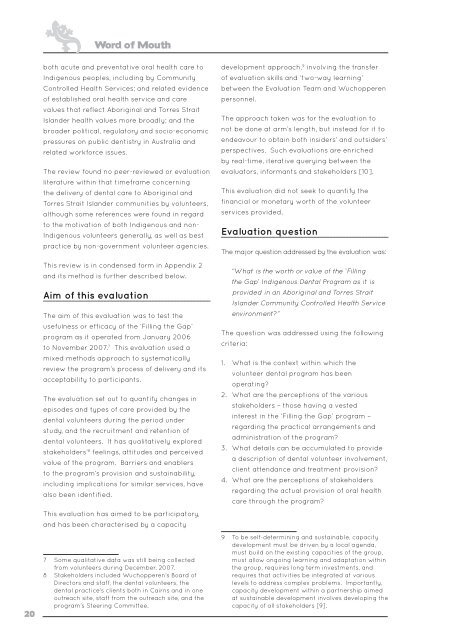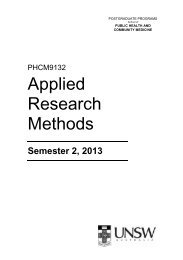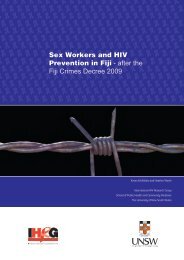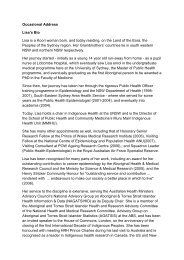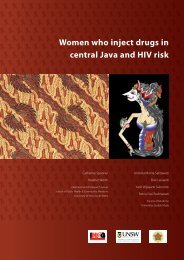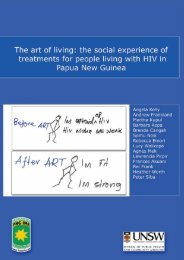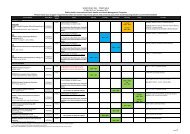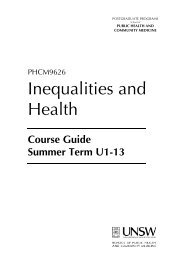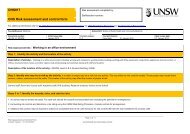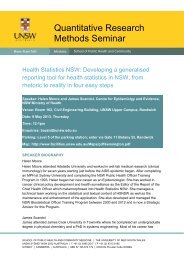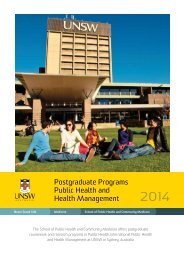Word of Mouth - School of Public Health and Community Medicine ...
Word of Mouth - School of Public Health and Community Medicine ...
Word of Mouth - School of Public Health and Community Medicine ...
- No tags were found...
Create successful ePaper yourself
Turn your PDF publications into a flip-book with our unique Google optimized e-Paper software.
<strong>Word</strong> <strong>of</strong> <strong>Mouth</strong>20both acute <strong>and</strong> preventative oral health care toIndigenous peoples, including by <strong>Community</strong>Controlled <strong>Health</strong> Services; <strong>and</strong> related evidence<strong>of</strong> established oral health service <strong>and</strong> carevalues that reflect Aboriginal <strong>and</strong> Torres StraitIsl<strong>and</strong>er health values more broadly; <strong>and</strong> thebroader political, regulatory <strong>and</strong> socio-economicpressures on public dentistry in Australia <strong>and</strong>related workforce issues.The review found no peer-reviewed or evaluationliterature within that timeframe concerningthe delivery <strong>of</strong> dental care to Aboriginal <strong>and</strong>Torres Strait Isl<strong>and</strong>er communities by volunteers,although some references were found in regardto the motivation <strong>of</strong> both Indigenous <strong>and</strong> non-Indigenous volunteers generally, as well as bestpractice by non-government volunteer agencies.This review is in condensed form in Appendix 2<strong>and</strong> its method is further described below.Aim <strong>of</strong> this evaluationThe aim <strong>of</strong> this evaluation was to test theusefulness or efficacy <strong>of</strong> the ‘Filling the Gap’program as it operated from January 2006to November 2007. 7 This evaluation used amixed methods approach to systematicallyreview the program’s process <strong>of</strong> delivery <strong>and</strong> itsacceptability to participants.The evaluation set out to quantify changes inepisodes <strong>and</strong> types <strong>of</strong> care provided by thedental volunteers during the period understudy, <strong>and</strong> the recruitment <strong>and</strong> retention <strong>of</strong>dental volunteers. It has qualitatively exploredstakeholders’ 8 feelings, attitudes <strong>and</strong> perceivedvalue <strong>of</strong> the program. Barriers <strong>and</strong> enablersto the program’s provision <strong>and</strong> sustainability,including implications for similar services, havealso been identified.This evaluation has aimed to be participatory,<strong>and</strong> has been characterised by a capacity7 Some qualitative data was still being collectedfrom volunteers during December, 2007.8 Stakeholders included Wuchopperen’s Board <strong>of</strong>Directors <strong>and</strong> staff, the dental volunteers, thedental practice’s clients both in Cairns <strong>and</strong> in oneoutreach site, staff from the outreach site, <strong>and</strong> theprogram’s Steering Committee.development approach, 9 involving the transfer<strong>of</strong> evaluation skills <strong>and</strong> ‘two-way learning’between the Evaluation Team <strong>and</strong> Wuchopperenpersonnel.The approach taken was for the evaluation tonot be done at arm’s length, but instead for it toendeavour to obtain both insiders’ <strong>and</strong> outsiders’perspectives. Such evaluations are enrichedby real-time, iterative querying between theevaluators, informants <strong>and</strong> stakeholders [10].This evaluation did not seek to quantify thefinancial or monetary worth <strong>of</strong> the volunteerservices provided.Evaluation questionThe major question addressed by the evaluation was:“What is the worth or value <strong>of</strong> the ‘Fillingthe Gap’ Indigenous Dental Program as it isprovided in an Aboriginal <strong>and</strong> Torres StraitIsl<strong>and</strong>er <strong>Community</strong> Controlled <strong>Health</strong> Serviceenvironment?”The question was addressed using the followingcriteria:1. What is the context within which thevolunteer dental program has beenoperating?2. What are the perceptions <strong>of</strong> the variousstakeholders – those having a vestedinterest in the ‘Filling the Gap’ program –regarding the practical arrangements <strong>and</strong>administration <strong>of</strong> the program?3. What details can be accumulated to providea description <strong>of</strong> dental volunteer involvement,client attendance <strong>and</strong> treatment provision?4. What are the perceptions <strong>of</strong> stakeholdersregarding the actual provision <strong>of</strong> oral healthcare through the program?9 To be self-determining <strong>and</strong> sustainable, capacitydevelopment must be driven by a local agenda,must build on the existing capacities <strong>of</strong> the group,must allow ongoing learning <strong>and</strong> adaptation withinthe group, requires long term investments, <strong>and</strong>requires that activities be integrated at variouslevels to address complex problems. Importantly,capacity development within a partnership aimedat sustainable development involves developing thecapacity <strong>of</strong> all stakeholders [9].


